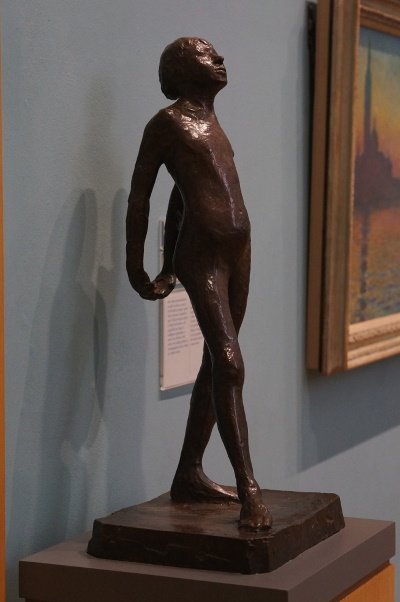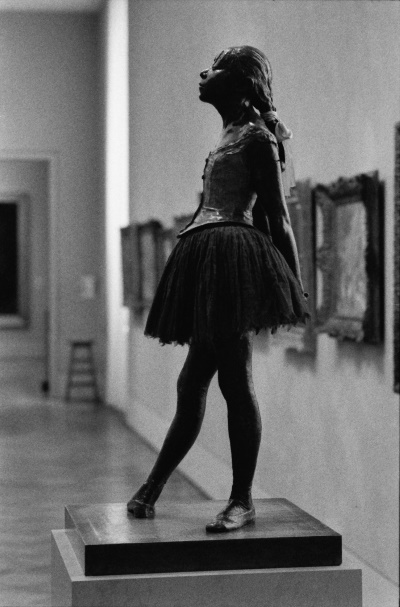 |
98. Statuesque
I was surprised to find an unfamiliar version of
Degas’s bronze of the little dancer at the National
Museum Cardiff. This version has Marie van Goethem
naked and waiting to be clothed. Marie left her
working-class parents in Belgium and came to Paris to
learn ballet. She presents a fourth-position stance.
When the statue was first exhibited, plenty of men
described her as ugly. It was a time when the Paris
ballerinas were often targeted by pedophiles and, from
what I read, Degas was a misogynist. Afterwards, Marie
disappeared from history leaving only the many
versions of her in statues as the last record of her
existence.
In all the previous statues of Marie that I have seen
she is wearing a tutu, a corset, and sometimes a
ribbon in her hair. Those versions came after the one
in Cardiff. This one in Cardiff has not even the same
face.
The one I admire is in the Philadelphia Museum of Art,
Degas's La Petite Danseuse de Quatorze Ans (Little
Dancer, Aged Fourteen). That 39-inch bronze exists in
multiple copies displayed in more than two dozen
museums. Each is slightly different, usually the color
of her tutu. She's adorable. There is an expression of
impudence on her face and for that she reminds me of
my friend Stephanie.

I have
known Stephanie since high school. Young men fell in
love with her. My friends fell in love with her. I
never did, but I could see what it was. Slight of
build, she moved with a natural grace. She was
comfortable in her clothes, dressing to a personal
taste that was not dictated by the latest fashion nor
aimed at exciting young men already driven mad by
out-of-control hormones.
Stephanie had contempt for small talk or maybe it was
shyness. She didn’t suffer the superficial, but she
flamed when the subject was art and culture, losing
herself in the esoteric. She was independent and not
one of the girls. Never talking much, but when she did
her few words were interesting. It was never about
herself. Her reluctance to speak made her mysterious.
When we conversed, it felt like we were in a French
film.
Ah, but when I was sixteen and living at home, on my
bedroom wall hung a large black and white poster of
Sophia Loren, the iconic moment when she returns to
the boat, her skimpy clothing soaked and translucent.
The still was from the 1957 film Boy on a Dolphin,
which I never saw and didn’t realize was in color, a
film that also happens to be about a statue. It was
how the ubiquitous culture of my age directed my
instincts, molded my tastes.
Forty-five years ago, I left Ricker College in
Houlton, Maine without completing my education in
order to pursue a romance. I followed my sweetheart
who was also leaving school to return home to Boston.
I cannot say if she was promising a relationship or I
had deluded myself into believing one was forthcoming.
I was young and poisoned by the hormones raging
through my body. She was a bombshell, sexually
irresistible. Nothing came of it and I found myself
living in Brookline, adjacent to Boston, and working
as a clerk for the Social Security Administration. I
went to the museums a lot.
On one visit to the Museum of Fine Arts in Boston, an
easy stroll across Riverway Park and the Muddy River,
I found a small bronze figure of a standing woman
wrapped in a cloak. However, she was lifting the cloak
open to reveal her demure face and pert breasts. The
title of the piece was “Nature Unveiling Herself
Before Science”, a 23-inch bronze by Louis-Ernest
Barrias. Nature was attractive. I lusted to own the
piece. I thought the allegory very clever at the time.
Recalling the statuette now causes me to laugh. Only a
horny man would credit the erotic pose as an allegory
to the pursuit of science. The statue was not
describing a passion for science. It was, if anything,
a distraction from the pursuit of science. The
figurine will not hold the same symbolism for the
woman scientist, unless she is a lesbian. Could there
be another bronze with the same title showing instead
the figure of a young man drawing apart his cloak to
reveal his penis and calling it “Nature Unveiling
Himself Before Science”?
I have become the old man, yet my eyes still lust at
the sight of nubile women. Long ago, my youthful
passions for women like Sophia Loren and Raquel Welch
with time gave way to more sophisticated tastes,
switching my allegiance to Lauren Bacall, Greta Garbo,
and Audrey Hepburn. I do not say Audrey Hepburn
without sighing.
Then I met Ms Keogh. She would become my cherished
companion. In a few days, the seventh of March, it
will be our 33rd wedding anniversary - had she lived.
37 years ago, on a warm summer night, I rode Amtrak’s
Night Owl coming up from New York City to court her.
Because Ms Keogh lived in Canton, a suburb of Boston,
I used to get off the train at Route 128, a stop
before Boston. That summer morning, she was not there
to meet me. I had a long wait before her appearance.
Further south, she came out of the woods that lined
the track and danced, balancing on the rail in a
flowing long skirt, a slender nymph. She was the
“Spirit of Ecstasy” on the hood of a Rolls-Royce.
![]()
Mr Bentzman will continue to report here regularly about
the events and concerns of his life. If you've any
comments or suggestions, he would be pleased to hear from you.
You can find his
several books at www.Bentzman.com.
Enshrined
Inside Me, his second collection of
essays, is now available to purchase.
